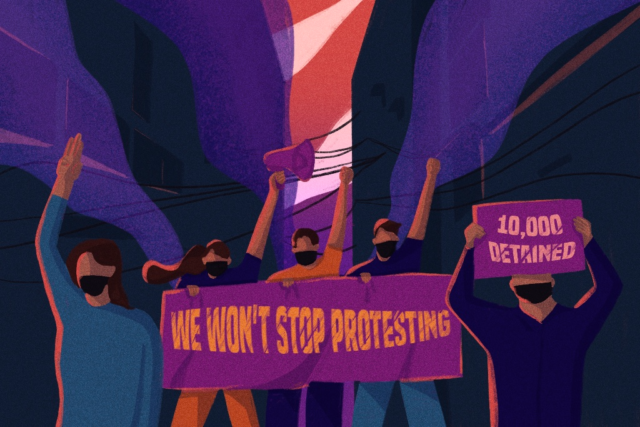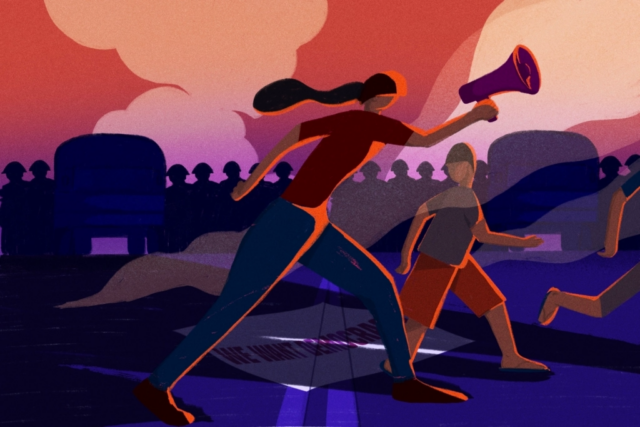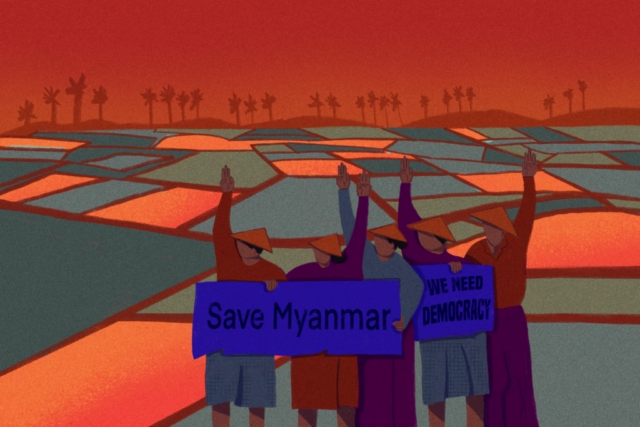Myanmar: International community must do more to protect brave protesters
22 April 2022


- Failure to stop violence one year after ASEAN’s adoption of its Five-Point Consensus
- Activists inside Myanmar resorting to flash mobs and silent strikes to avoid crackdown
- Plainclothes military forces disguise themselves as fruit sellers and trishaw drivers as part of the repressive surveillance system
- Military retaliates against family members of activists
Myanmar’s brave activists are still pursuing peaceful protests despite grave danger and numerous challenges, Amnesty International said today, one year after the Association of Southeast Asian Nations (ASEAN) adopted a Five-Point Consensus that has abjectly failed to stop the violence in the country.
In recent months, Amnesty International conducted in-depth interviews with 17 people who have continued to take part in non-violent protests across five of Myanmar’s states and regions. The interviewees were from a diverse array of protest groups, including LGBTQ and women’s rights organizations.
One of the most popular methods of protesting has been “flash mobs” where activists run through the streets for a few minutes before dispersing to avoid being shot, arrested or run over by military vehicles.
The public has also held “silent strikes” across the country, during which shops and businesses shut down, roads emptied, and people stayed home to show defiance to military rule.
Across Myanmar, activists and human rights defenders have been distributing pamphlets on buses, posting messages against the military on walls with stickers or spray paint, and encouraging boycotts of goods and services with ties to the military.
“These activists urgently need the support of the international community in the form of a global arms embargo to stop the Myanmar military from using weapons of warfare to kill peaceful protesters,” said Emerlynne Gil, Amnesty International’s Deputy Regional Director for Research.
These activists urgently need the support of the international community in the form of a global arms embargo to stop the Myanmar military from using weapons of warfare to kill peaceful protesters.
Emerlynne Gil, Amnesty International’s Deputy Regional Director for Research
“The ASEAN must call on the Myanmar military authorities to immediately stop all violence against peaceful protestors in line with the stalled Five-Point Consensus. It should do so now to prevent the Myanmar people from further suffering.”
“It must also continue to unequivocally condemn all human rights violations in Myanmar and call for the release of all individuals who are arbitrarily detained.”
“THEY TRIED TO HIT ME”

JC
In the days immediately following the coup, Amnesty International and many other human rights groups urged the military to stop the use of unlawful and lethal force against peaceful protesters. The violence has since prompted many to join armed resistance groups, which are active throughout the country.
Amnesty International has called on the military to exercise restraint, abide by international law, and for law enforcement duties to be fully resumed by police.
These calls have gone unheeded. More than 1,700 people have now been killed, and more than 13,000 arrested since the military took power, according to the Assistance Association for Political Prisoners.
Activists and human rights defenders interviewed by Amnesty International described witnessing or experiencing abuses by military forces while demonstrating, including shootings, beatings, and attempts to ram vehicles into protests.
The brutal response of the military had an enormous impact on the nonviolent protest movement. During the latter part of 2021, there was a noticeable decrease in the number of people who joined protests in the streets.
“We went from tens of thousands to thousands, thousands to hundreds, and hundreds to around twenty,” said Thiri*, a university student in Mandalay who said she had no interest in politics before the coup but is now one of the leaders of a women’s protest group.
We went from tens of thousands to thousands, thousands to hundreds, and hundreds to around twenty.
Thiri*, university student in Mandalay
However, the reduced number of protesters taking to the streets may also be a matter of strategy. Some of the activists that Amnesty International spoke with said they were intentionally organizing the protests in smaller groups to keep everyone safe.
Rina, a university student and member of the General Strike Committee in Yangon, said that it had become “too dangerous” to protest in large groups.
She participated in a flash mob with around 20 other people on 5 December 2021 and she recounted to Amnesty International that on that day, as they gathered, a military truck drove straight into them. “As I was running, I saw some of the other people who joined in the flash mob had been hit [by the military truck]. Some of them were rolling on the pavement.”
In the Kachin State capital of Myitkyina, a university student who has been protesting with the University of Myitkyina Students’ Union, said that they usually go out in smaller groups because “if there are too many people in the protest, it is easier to get arrested.”
Zin Mar, another university student who is a protest leader in Monywa, said that although her protest group sometimes had to reduce the number of people demonstrating for security reasons, they were determined to continue. “We will always come out whenever we can,” she said.
Min Thu, a high school student who is a leading member of the Mandalay Youth Strike Committee, has witnessed unmarked vehicles which he believes to belong to the military and police accelerate into protesters during at least three instances. In October 2021, a motorcycle nearly hit him when he was about to join a protest.
“Just before we started the protest, they tried to hit me [with the vehicle] from the front,” Min Thu said. “I escaped by going to the nearest road and then they got down from their vehicle and pointed guns at me. They didn’t shoot me because they had blocked all the angles, and they thought they would arrest me.” He told Amnesty International that he dodged onto a side street and barely escaped.
In Sagaing region’s Salingyi and Yinmarbin townships, poet and engineer Yar Zar has regularly organized people across villages to protest since March of last year, and was at two protests when soldiers and police opened fire at the crowd.
To avoid encountering soldiers, he and his team carefully prepare routes along narrow, unpaved streets. He is one of several people who told Amnesty International that they also rely on volunteers to check and make sure the route is clear before they demonstrate.
“When we protest in the village, some protesters who act as lookouts escort us so we can avoid the military. Once they have passed, we start our protest again,” said Phyu, a village protest leader in Thayetchaung township, Tanintharyi region.
Protest groups have also been distributing pamphlets and using social media to call for a boycott of goods and services with ties to the military, and have been posting anti-coup messages in public spaces.
LIFE ON THE RUN

JC
Many activists described to Amnesty International how they felt like they were constantly watched and followed by civilian informants known as dalans or by soldiers and police wearing civilian clothes and driving unmarked vehicles.
Myat Min Khant of the All Burma Federation of Student Unions said that the military and police roam streets disguised as fruit sellers or trishaw, motorcycle, or taxi drivers and embed themselves among the people to surveil anyone daring to express dissent.
There are also numerous checkpoints in towns and cities around the country. People are stopped at random, and their belongings are searched by soldiers and police. Thus, activists either leave their devices at home or delete messages and applications on devices when they go out for fear that they could be arrested.
Surveillance by the military adds to the challenges in organizing protests, according to Moe Thouk, a protest leader with the General Strike Committee in Yangon.
They use CCTV cameras to follow activists, employ dalans in every ward to gather information, and arrest activists while wearing civilian clothes, he said. “They roam around places where protests often take place. We need to carefully choose the right place [to protest] and rely on scouts for safety,” said Moe Thouk.
Most of the activists who spoke to Amnesty International said that they have left their homes for safety reasons, and several of them have not been able to be back home at all since February 2021.
“If I go back home, the military may be waiting to arrest me,” said Nan Lin of the University Students’ Union Alumni Force. “Even my family members do not know my whereabouts.”
If I go back home, the military may be waiting to arrest me…even my family members do not know my whereabouts.
Nan Lin, University Students’ Union Alumni Force
BP, a protest leader who has demonstrated on the streets of Kalay, Sagaing region every day since 7 February 2021, said that a convoy of five vehicles full of soldiers raided his family home three times in one day in September 2021. He is one of four protesters interviewed who said their homes have been raided after they have left and gone into hiding.
But while they fear going home, many of these activists said it is becoming harder and harder to find safe places to hide. BP told Amnesty International that he regularly sees strangers who he believes are plainclothes informants loitering near the vicinity where activists are staying or following them on motorbikes while carrying walkie-talkies.
U Yaw, a monk from Ayeyarwady region who has been actively protesting since the early days after the coup, had been in hiding since March 2021 when his monastery was raided. During the raid, as U Yaw hid in a toilet stall, he overheard soldiers saying that if they found him, they should “just shoot him dead and get rid of him.”
He fled to Mandalay and resumed protesting, but soldiers and police raided the monastery there where he was hiding in June. He took shelter in another monastery which was raided by soldiers and police in September 2021.
He escaped just in time, but the soldiers and police confiscated his identification documents and cash. U Yaw continued to protest despite the risks.
THREATENING FAMILY MEMBERS

JC
In many cases, soldiers and police have taken into custody family members and loved ones of activists if they were unable to find the activists and arrest them, including a politicians’ 94-year-old mother and an activist’s four-year-old daughter, according to media reports
In April 2021, soldiers and police raided the house of Arkar, an activist who had gone into hiding.
“Because they couldn’t find me and arrest me, they arrested my mother,” he said. “I got a call from the police station and I was told that I should give myself up in exchange for the freedom of my mother.”
Arkar did not turn himself in, and his relatives were able to negotiate his mother’s release the next day by paying a bribe. Arkar’s family have since moved to a new home to avoid further reprisals. Arkar is one of four people who told Amnesty International that their families were forced to leave their homes because of safety concerns.
In November 2021, the military attempted to raid the house of another protest leader who had gone into hiding. “When they arrived, they started shooting, but they went to the wrong house. They mistakenly went to our neighbor’s house and one woman was killed because of the shooting,” the activist said.
Her family was able to escape but she has not contacted them since for fear that she would be putting their lives at further risk. She is currently moving from place to place, and said she has trouble sleeping due to fear of arrest.
“We have to be vigilant 24 hours a day. We get startled even when we just hear a cat jumping onto the roof. We worry about getting arrested when we go out, and when we are in the house, we are scared they will come in and arrest us. We have completely lost our sense of security,” she said.
We have to be vigilant 24 hours a day. We get startled even when we just hear a cat jumping onto the roof.
Protest leader
She is determined, though, to continue organizing peaceful protests. “I cannot sit quietly when I see injustice,” she told Amnesty International.
A resolve to keep protesting nonviolently is shared by many of the activists.
“Despite the immense dangers and hardships, there are still many activists and human rights defenders who choose to remain in Myanmar and who are unwavering in their commitment to continue peacefully protesting and expressing their dissent,” Amnesty’s Emerlynne Gil said.
Many of them said they continue their peaceful protests to inspire more people in the country to action and to give people hope. “The main reason I continue protesting is so that the people do not become divided or lose enthusiasm, and so that they can get strength by seeing us,” said the monk in Mandalay, U Yaw.
“Although our lives are in danger, we choose to continue. We will keep asking the world to help us because people are being killed in Myanmar,” said Zin Mar, the protest leader in Monywa.
*Note to editors: In several cases pseudonyms have been used at the request of interviewees
Announcements
21 May 2025
Open letter: Malaysia must lead ASEAN with principle, not hypocrisy, to address the Myanmar crisis

Progressive Voice is a participatory rights-based policy research and advocacy organization rooted in civil society, that maintains strong networks and relationships with grassroots organizations and community-based organizations throughout Myanmar. It acts as a bridge to the international community and international policymakers by amplifying voices from the ground, and advocating for a rights-based policy narrative.